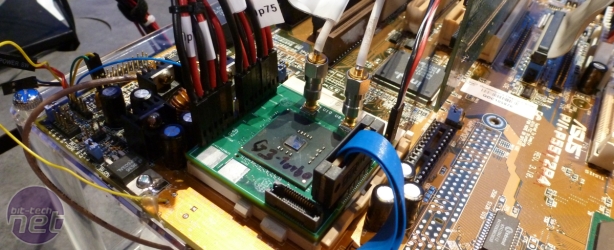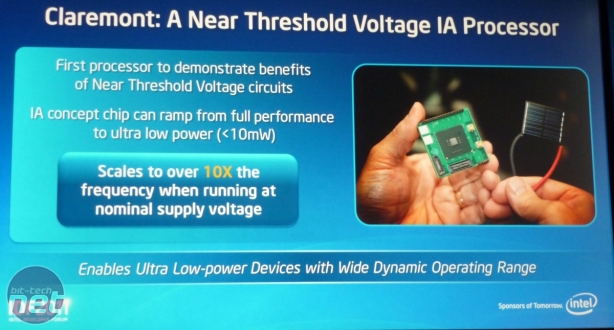
Intel Names The Solar-Powered CPU
Intel has named its solar-powered CPU, which it first showed at IDF 2011 a few days ago. Codenamed Claremont, the CPU is based around an old Socket 7 Pentium design but has been modified to operate at a peak power consumption of less than 10mW. Ultra-low voltage CPUs currently consume 15W or more, which is roughly 1,500 times as much power.
The low power draw is a consequence of a new technique used to apply voltage to a silicon chip called Near Threshold Voltage. The idea is based on the principle that processors are currently given plenty of voltage to ensure that the transistors within switch with no trouble, but by reducing the applied voltage to be just above the required level for transistor switching – the threshold voltage – you can decrease the vcore and therefore power draw (and waste heat).
It's basically the same principle as underclocking and undervolting a hand-me-down CPU from a retired desktop PC in order to build a basic, quiet PC. However, we’re not sure whether the solar-powered CPU on show had any other technology inside to help achieve the low power draw.
In fact, we’re not even sure what the solar-powered CPU project illustrates. When we first saw the CPU on day one of IDF, we thought it was a demonstration of how Intel is pushing down the power draw of x86 CPUs.
However, a part of the reveal of the solar-powered CPU’s name was the fact that Intel could have reduced the power draw by orders of magnitude still by using a current architecture. We were even told that Intel didn’t have any motherboards lying around to use, so it had to search eBay and scrounge from dumpsters to find the Asus P/I-P55TZP4 pictured. Then Intel had to modify these boards to allow the desired ultra-low voltages, which we believe to be in the region of 0.01V*.
Intel then revealed that it saw a 10x performance boost from running the CPU at its ‘nominal voltage.’ What Claremont seems to be offering is a tiny power draw when asked to do moderately taxing tasks, but the ability to boost up to a normal power draw and level of performance on demand. We could therefore see the solar-powered CPU demonstration as showing a new type of SpeedStep; one where CPUs don’t necessarily boost to a maximum speed and power draw.
* Socket 7 Pentium CPUs have TDPs of 15.6-20.6W and vids of 2.85-3.6V, giving amperages of 4.7-7.1A. Assuming that Claremont has a TDP of 0.08W, this gives us a vcore of 0.011-0.017V (amps/volts=watts).
Sources: Intel Ark, Wikipedia

MSI MPG Velox 100R Chassis Review
October 14 2021 | 15:04










Want to comment? Please log in.